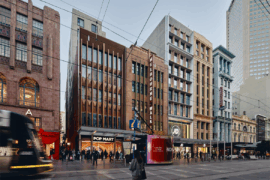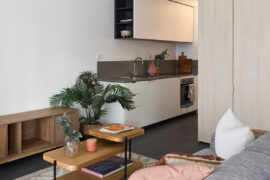What do you get when ABW architectural principles are fused with an agile way of working? We talked to members of the futurespace team and REA Group’s CIO Nigel Dalton about their collaboration on REA’s new Melbourne headquarters. Marg Hearn reports.
August 19th, 2015
Dynamic digital property advertising business, REA Group started modestly in a suburban garage in Doncaster, Melbourne in 1995. Ten years on, with 600 staff and growing, the ASX-listed REA Group owns and operates market-leading Australian residential and commercial property websites: realestate.com.au and realcommercial.com.au. Internationally their interests include Chinese property site myfun.com and European sites casa.it, at Home.lu and immoRegion.fr.
According to Nigel Dalton, REA Group’s chief information officer (CIO), a new digital start-up company emerges almost weekly, with the goal of being “the next big thing” in the real estate industry. REA Group’s new Melbourne headquarters, designed in collaboration with futurespace interior and architecture practice, “is a response to the pace of those disruptive technologies.”
“Blending REA Group’s lean and agile system of working in multi-disciplinary teams – with futurespace’s Activity Based Working (ABW) expertise, produced a very unique workplace – which we’ve christened – Neighbourhood Based Working,” Dalton says.
The new workplace design unshackled REA Group from the constraints of legacy technologies and workspaces to “better support their collaborative and agile way of working,” explains Angela Ferguson, futurespace managing director.
Custom design agile walls were one creative product evolved for the project by Gavin Harris futurespace design director in partnership with Schiavello. The solution overcame the “big challenge” of facilitating REA’s process of working on walls and collaboration in an open working environment. The design of different spaces, nooks and crannies near a central marketplace and main street was a strategy to “multiply random bump-in factor and interaction between neighbourhoods.” The idea being – that increased opportunities for staff connection and communication help to foster innovation. “It’s a project that balanced – the need to address people, place and technology with equal importance,” Ferguson says.
Read the full story in Indesign Issue 62, available on sale August 20.
INDESIGN is on instagram
Follow @indesignlive
A searchable and comprehensive guide for specifying leading products and their suppliers
Keep up to date with the latest and greatest from our industry BFF's!

In an industry where design intent is often diluted by value management and procurement pressures, Klaro Industrial Design positions manufacturing as a creative ally – allowing commercial interior designers to deliver unique pieces aligned to the project’s original vision.

Now cooking and entertaining from his minimalist home kitchen designed around Gaggenau’s refined performance, Chef Wu brings professional craft into a calm and well-composed setting.

Merging two hotel identities in one landmark development, Hotel Indigo and Holiday Inn Little Collins capture the spirit of Melbourne through Buchan’s narrative-driven design – elevated by GROHE’s signature craftsmanship.

At the Munarra Centre for Regional Excellence on Yorta Yorta Country in Victoria, ARM Architecture and Milliken use PrintWorks™ technology to translate First Nations narratives into a layered, community-led floorscape.
The HBO+EMTB Sydney studio hosted a party on Wednesday 29 February to celebrate the opening of Rugby League Central. Special guests included ARLC Chief Executive David Gallop and the Minister for Sport and Recreation, The Honourable Graham Annesley MP. NRL stars Mario Fenech and Andrew Ryan helped draw the lucky door prize, which was followed by guided tours of the building.

It is with sorrow that we share the news of the passing of Flack Studio’s Mark Robinson. One of the Australian design world’s most beautiful people, Mark was that rare person who only saw good in fostering friendships and collaboration.
Indesign’s Penny Craswell catches up with Phill Slattery and Perry McNeilage at Saturday in Design to talk about their modern classic, the ’Stiletto’.

X + O has completed a wellness studio that rivals the rest. Located in downtown Rosebery, an inner-city suburb of Sydney, Body WRL is a sanctuary for wellbeing that is beautiful and technologically advanced, with treatments that are guaranteed to soothe the inner beast. It’s just what the doctor should be ordering!
The internet never sleeps! Here's the stuff you might have missed

From furniture and homewares to lighting, Dirk du Toit’s Melbourne-based studio Dutoit is built on local manufacturing, material restraint and the belief that longevity is central to sustainable design.

Boronia Apartments in Waterloo, designed by TURNER for City West Housing, delivers 74 affordable rental homes that combine sustainable design with long-term community-focused living.